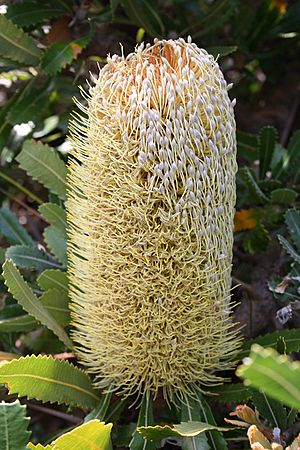Banksia subg. Banksia facts for kids
Quick facts for kids Banksia subg. Banksia |
|
|---|---|
 |
|
| Banksia serrata (Saw Banksia), the type species of Banksia. | |
| Scientific classification | |
| Kingdom: | |
| (unranked): | |
| (unranked): | |
| Order: | |
| Family: | |
| Genus: | |
| Subgenus: |
Banksia L.f. subg. Banksia
|
Banksia subg. Banksia is a scientific name for a large group of plants within the Banksia genus. Think of it like a major family branch. This group always includes the famous Banksia serrata, also known as the Saw Banksia, which is the original type of Banksia plant. Over time, scientists have changed how they define and organize this group.
Contents
Early Discoveries: Banksia verae
The story of Banksia subg. Banksia began in 1810 with a botanist named Robert Brown. He published a book where he divided all Banksia plants into two main groups. One group, which he called Banksia verae, included most Banksia species. These plants had the long, spiky flower heads that are typical of Banksias.
The only exception was B. ilicifolia (Holly-leaved Banksia), which has a more dome-shaped flower head. Brown placed this unique plant in its own separate group called Isostylis. Later, in 1830, Brown added many more species to the Banksia verae group.
New Name: Eubanksia
Years later, in 1847, another botanist named Stephan Endlicher changed the name Banksia verae to Eubanksia. This new name was kept by Carl Meissner in his plant arrangement from 1856.
Meissner further divided Eubanksia into four smaller groups, or "series," based mainly on the shape of their leaves. However, these groups often contained very different types of plants, making them a bit messy, except for one series that included species with hooked flower parts.
Alex George's Modern View of Banksia subg. Banksia
In 1981, Alex George published a very important book about Banksia plants. He brought back the idea of two main subgenera, similar to Brown's original idea: Eubanksia and Isostylis. However, because of new rules in naming plants, Eubanksia had to be officially renamed B. subg. Banksia.
George updated his work in 1999, and his system is still widely used today, even though some newer studies suggest different ways to group the plants.
In George's system, B. subg. Banksia is split into three main sections, mostly based on the shape of the style (a part of the flower that helps with reproduction):
- B. sect. Banksia: This is the largest section, with about 50 species. Their styles are straight or curved, but never hooked. This section is further divided into nine smaller groups.
- B. sect. Coccinea: This section contains only one species, the beautiful Banksia coccinea.
- B. sect. Oncostylis: This section includes about 20 species that all have hooked styles. It is divided into four smaller groups.
Understanding Plant Family Trees: Thiele and Ladiges' View
In 1996, scientists Kevin Thiele and Pauline Ladiges used a method called cladistics to study Banksia plants. Cladistics helps scientists understand how different species are related, like building a family tree. They found that Alex George's arrangement was mostly correct, but they suggested some small changes.
Their study showed that the B. subg. Banksia group might not be a single, complete family branch unless B. elegans (Elegant Banksia) was removed. They listed B. elegans and five other species as incertae sedis, which means their exact place in the family tree was uncertain. Otherwise, they kept George's main grouping for the subgenus.
In Thiele and Ladiges' system, B. subg. Banksia is divided into twelve series.
The Latest Ideas: Mast and Thiele's View
More recently, in 2005, Austin Mast, Eric Jones, and Shawn Havery used DNA information to study Banksia plants. Their findings suggested a very different family tree for Banksia. They even found that another group of plants, Dryandra, was actually part of Banksia.
Because of this, in 2007, Mast and Thiele started to rearrange the Banksia genus. They moved Dryandra into Banksia and created a new subgenus called B. subg. Spathulatae for plants with spoon-shaped cotyledons (the first leaves of a seedling). This meant that B. subg. Banksia was redefined to include all the Banksia species that don't have spoon-shaped cotyledons. They plan to publish a full new arrangement once they have finished studying the DNA of all Dryandra species.
Images for kids
See also
 In Spanish: Banksia subg. Banksia para niños
In Spanish: Banksia subg. Banksia para niños


